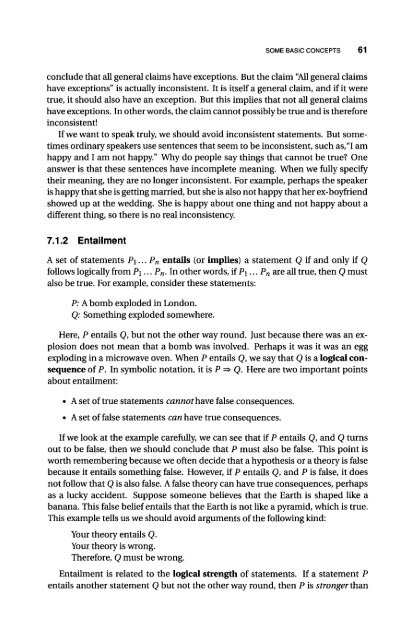An Introduction to Critical Thinking and Creativity - always yours
An Introduction to Critical Thinking and Creativity - always yours
An Introduction to Critical Thinking and Creativity - always yours
Create successful ePaper yourself
Turn your PDF publications into a flip-book with our unique Google optimized e-Paper software.
SOME BASIC CONCEPTS 61<br />
conclude that all general claims have exceptions. But the claim "All general claims<br />
have exceptions" is actually inconsistent. It is itself a general claim, <strong>and</strong> if it were<br />
true, it should also have an exception. But this implies that not all general claims<br />
have exceptions. In other words, the claim cannot possibly be true <strong>and</strong> is therefore<br />
inconsistent!<br />
If we want <strong>to</strong> speak truly, we should avoid inconsistent statements. But sometimes<br />
ordinary speakers use sentences that seem <strong>to</strong> be inconsistent, such as,"I am<br />
happy <strong>and</strong> I am not happy." Why do people say things that cannot be true? One<br />
answer is that these sentences have incomplete meaning. When we fully specify<br />
their meaning, they are no longer inconsistent. For example, perhaps the speaker<br />
is happy that she is getting married, but she is also not happy that her ex-boyfriend<br />
showed up at the wedding. She is happy about one thing <strong>and</strong> not happy about a<br />
different thing, so there is no real inconsistency.<br />
7.1.2 Entailment<br />
A set of statements P\...P n entails (or implies) a statement Q if <strong>and</strong> only if Q<br />
follows logically from Pi... P n . In other words, if Pi... P n are all true, then Q must<br />
also be true. For example, consider these statements:<br />
P: A bomb exploded in London.<br />
Q: Something exploded somewhere.<br />
Here, P entails Q, but not the other way round. Just because there was an explosion<br />
does not mean that a bomb was involved. Perhaps it was it was an egg<br />
exploding in a microwave oven. When P entails Q, we say that Q is a logical consequence<br />
of P. In symbolic notation, it is P => Q. Here are two important points<br />
about entailment:<br />
• A set of true statements cannot have false consequences.<br />
• A set of false statements can have true consequences.<br />
If we look at the example carefully, we can see that if P entails Q, <strong>and</strong> Q turns<br />
out <strong>to</strong> be false, then we should conclude that P must also be false. This point is<br />
worth remembering because we often decide that a hypothesis or a theory is false<br />
because it entails something false. However, if P entails Q, <strong>and</strong> P is false, it does<br />
not follow that Q is also false. A false theory can have true consequences, perhaps<br />
as a lucky accident. Suppose someone believes that the Earth is shaped like a<br />
banana. This false belief entails that the Earth is not like a pyramid, which is true.<br />
This example tells us we should avoid arguments of the following kind:<br />
Your theory entails Q.<br />
Your theory is wrong.<br />
Therefore, Q must be wrong.<br />
Entailment is related <strong>to</strong> the logical strength of statements. If a statement P<br />
entails another statement Q but not the other way round, then P is stronger than
















